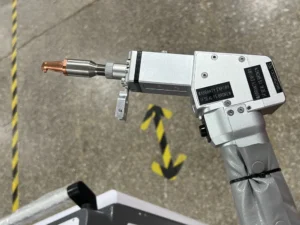Introduction:
The use of handheld laser welding machines has become widespread currently. It is popular among users because of its simple operation, portability, and fast welding speed. When using a handheld laser welding machine, some problems may arise. This article will explain how to determine whether the welding gun lens is damaged and how to prevent it in advance.
How to judge whether protective lenses are damaged: Weak Light

1. Phenomenon and Problems
The light is strong at first and gradually weakens, resulting in failure to fuse or sparks at the copper nozzle.
This situation is usually caused by damage to the welding gun lens, including but not limited to protective lens, focusing, collimation, reflection, etc. Damage to any one or more of these may cause this condition.
- Damage to the convex surface of the platform lens: This is usually caused by pollution. If not protected during replacement, dot-like black spots will appear.
- Damage to the flat surface of the platform lens: This is due to laser diffuse reflection, mostly caused by reflection. A focus is formed on the lens, and the coating is burned out, resulting in white spots. The convex surface also has this form, and the formation principle is the same.
2. Solutions
First, replace the protective lens and check the focus. Then, check the reflection and collimation and replace the damaged lens. Also, check whether the laser fiber tip is dirty or damaged.
Precautions When Using Protective Lens
1. During use, if the laser power suddenly becomes low, and there are phenomena such as the laser turning yellow and black smoke, please do not increase the power and continue welding.
You should promptly check whether there are foreign objects or burnt black spots on the lenses. The lenses include protective lenses, focusing lenses, and collimating lenses. If there are any, they need to be replaced in time before welding.
Protective lens→Focusing lens→Reflective lens→Collimation lens

2. Set the buffering slow-down parameters:
- light-on power about 30%
- light-off power about 80%
- gas-on delay 0-50ms
- gas-off delay 200-250ms
- light-off gradual time (delay) 150ms
- patching delay time 50-60ms
3. If the protective lens is not burned, but only the focusing and collimating lenses are burned, it may be that the lens was not replaced in the early stage. Foreign matter, such as dust, has entered the gun body. The solution is to clean the welding gun cavity and install a clean lens.
4. Use an ordinary argon gas pressure-reducing valve instead of an energy-saving one.
5. After the welding gun and optical fiber QBH are connected and locked, wrap them tightly with insulating tape to prevent dust from entering the gun body from the QBH interface. This achieves a double dust-proof effect.
6. When the welding process requirements are met, the welding power cannot be increased. The focus can be appropriately biased.
Maintenance and Replacement of Protective Lenses
1. Avoid pointing the gun head upward when welding. After getting off work, seal the copper mouth of the welding gun with masking paper or other cover. Place the gun head downward.
2. When the weather is hot, and a fan needs to be blown to cool down, the fan cannot face the welder and the welding gun head. The fan can be placed behind or on the back side of the welder. This prevents the fan from blowing dust into the gun head.
3. It is best to use original or high-quality lenses instead of inferior ones.
4. The gun head should be handled with care. It should not be knocked, hit, or dropped to avoid falling from high places.
5. When replacing the lens, your hands should be clean and dust-free. When removing the lens, the lens cavity should face downwards, and the lens cavity should be covered with masking paper. Hold the side of the lens and insert it, ensuring no dust enters the gun body.
Conclusion:
Handheld laser welding is a simple process, but its internal structure is relatively complex. The environmental requirements are lower than those of other laser welding machines. However, ensuring that the use environment meets the requirements is necessary. To make handheld laser welding machine work better, reduce the number of failures, and increase their work efficiency, we must understand the issues that should be paid attention to during their operation and how to deal with failures. I believe this article can be helpful to you. If you still have questions, please contact us.
